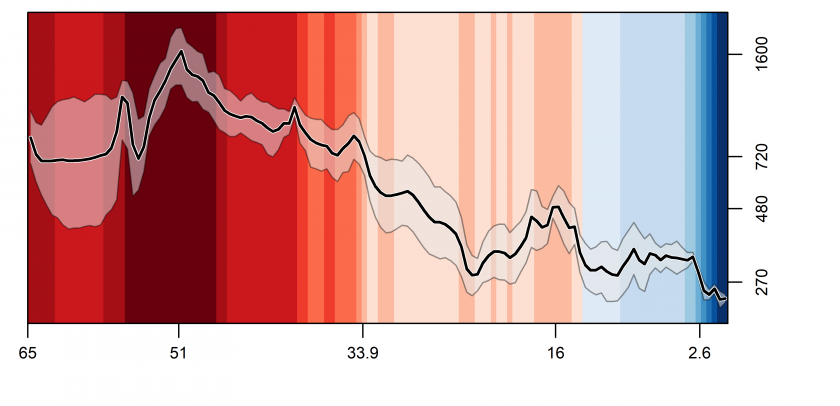A New 66 Million-Year History of Carbon Dioxide Offers Little Comfort for Today
December 8, 2023

A massive new reassessment of ancient atmospheric carbon dioxide (CO2) levels and corresponding temperatures lays out a daunting picture of where the Earth’s climate may be headed.
The study covers geologic records spanning the past 66 million years, putting present-day concentrations into context with deep time. Among other things, it indicates that the last time atmospheric CO2 consistently reached today’s human-driven levels was 14 million years ago — much longer ago than some existing assessments. It asserts that long-term climate is highly sensitive to the greenhouse gas, with cascading effects that may evolve over many millennia.

The study was assembled over seven years by a consortium of more than 80 researchers, including Daniel Breecker, a professor at The University of Texas at Austin Jackson School of Geosciences.
The research was published in the journal Science.
“We have long known that adding CO2 to our atmosphere raises the temperature,” said Bärbel Hönisch, a geochemist at Columbia University’s Lamont-Doherty Earth Observatory, who coordinated the consortium. “This study gives us a much more robust idea of how sensitive the climate is over long timescales.”
Most estimates of future warming draw on information from studies of how temperatures changed with CO2 in the past. To track CO2 levels over millions of years, scientists use a range of materials ranging from air bubbles trapped in ice cores, the chemistry of ancient soils and ocean sediments, and the anatomy of fossil plant leaves.
The consortium’s members did not collect new data; rather, they came together to sort through published studies to assess their reliability, based on evolving knowledge.
Breecker led the evaluation of studies of CO2 levels recorded by ancient soils, called “paleosols.”
Paleosols record past levels of CO2 in the environment because they contain calcium carbonate rock. The carbonate in this rock is made from carbon dioxide that was available in the surrounding environment as it formed.
Using geochemical techniques, scientists can distinguish atmospheric CO2 from other sources of CO2 – such as CO2 produced by microbial respiration – to produce a snapshot of the Earth’s past atmospheric concentrations of the greenhouse gas.
Breecker said that paleosols are a particularly important record of CO2 because they go back further in time than other records – such as ice , which may come and go as the planet’s climate changes – and do not reach a saturation point where they stop recording CO2 levels. What’s more, paleosols can also record data about the surrounding environment, such as changes in rainfall and plant life.
Breecker said that the strength of the study came from bringing communities of experts together to evaluate a range of records – from paleosols and beyond – with a critical eye.
“We really got a full representation of all the data and metadata that go into making these CO2 estimates for all the different proxies,” said Breecker, who is part of the Jackson School’s Department of Earth and Planetary Sciences.
The research led to some studies being excluded because they were found to be outdated or incomplete in the light of new findings. Others were recalibrated to account for the latest analytical techniques. In the end, the scientists used the data to create a new 66-million-year curve of CO2 versus temperatures based on all the evidence so far, coming to a consensus on what they call “earth system sensitivity.”
By this measure, they say, a doubling of CO2 is predicted to warm the planet a whopping 5 to 8 degrees Celsius (9 to 14 Fahrenheit). This is considerably higher than currently accepted estimates, which put average global temperatures 1.5 to 4.5 degrees Celsius (2.7 to 8.1 Fahrenheit) higher for every doubling of atmospheric CO2.
In the late 1700s, the air contained about 280 parts per million (ppm) of CO2 . The Earth is now up to 420 ppm, an increase of about 50%; by the end of the century, we could reach 600 ppm or more. As a result, we are already somewhere along the uncertain warming curve, with a rise of about 1.2 degrees Celsius (2.2 degrees Fahrenheit) since the late 19th century.
The results have one giant caveat: the earth system sensitivity described in the study is applicable to climate changes experienced by the planet over hundreds of thousands of years, not the decades and centuries that are immediately relevant to humans. The authors say that over long periods, increases in temperature may emerge from intertwined Earth processes that go beyond the immediate greenhouse effect created by CO2 in the air. These include melting of polar ice sheets, which would reduce the Earth’s ability to reflect solar energy; changes in terrestrial plant cover; and changes in clouds and atmospheric aerosols that could either heighten or lower temperatures.
“If you want us to tell you what the temperature will be in the year 2100, this does not tell you that. But it does have a bearing on present climate policy,” said coauthor Dana Royer, a paleoclimatologist at Wesleyan University. “It strengthens what we already thought we knew. It also tells us that there are sluggish, cascading effects that will last for thousands of years.”
Whatever temperatures eventually turn out to be, most estimates of future warming draw information from studies of how temperatures changed with CO2 in the past. The new study does not radically revise the generally accepted relationship between CO2 and temperature, but it does strengthen the understanding of certain time periods.
For example, the most distant period, from about 66 million to 56 million years ago, had been something of an enigma because the Earth was largely ice free yet some studies had suggested CO2 concentrations were relatively low. This cast some doubt on the relationship between CO2 and temperature. However, once the consortium excluded estimates they deemed the least dependable, they determined that CO2 was actually quite high—around 600 to 700 ppm, comparable to what could be reached by the end of this century.
The researchers also confirmed the long-held belief that the hottest period was about 50 million years ago, when CO2 spiked to as much as 1,600 ppm, and temperatures were as much as 12 degrees Celsius (21.6 Fahrenheit) higher than today. But by around 34 million years ago, CO2 had sunk enough that the present-day Antarctic ice sheet began developing. With some ups and downs, this was followed by a further long-term CO2 decline, during which the ancestors of many modern-day plants and animals evolved. This suggests, the paper’s authors say, that variations in CO2 affect not only climate, but ecosystems.
The new assessment says that about 16 million years ago was the last time CO2 was consistently higher than now, at about 480 ppm; and by 14 million years ago it had sunk to today’s human-induced level of 420 ppm. The decline continued, and by about 2.5 million years ago, CO2 reached about 270 or 280 ppm, kicking off a series of ice ages. It was at or below that when modern humans came into being about 400,000 years ago, and persisted there until the Industrial Era began about 250 years ago.
“Regardless of exactly how many degrees the temperature changes, it’s clear we have already brought the planet into a range of conditions never seen by our species,” said study coauthor Gabriel Bowen, a professor at the University of Utah. “It should make us stop and question what is the right path forward.”
The consortium has now evolved into a larger project that aims to chart how CO2 and climate have evolved over the entire Phanerozoic eon, from 540 million years ago to present.
This news release is adapted from a release published by the Columbia Climate School. Read the original release here.
For more information, contact: Anton Caputo, Jackson School of Geosciences, 210-602-2085; Monica Kortsha, Jackson School of Geosciences, 512-471-2241.
